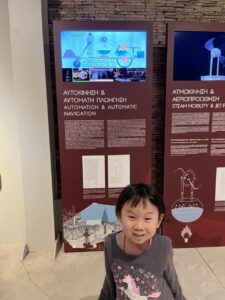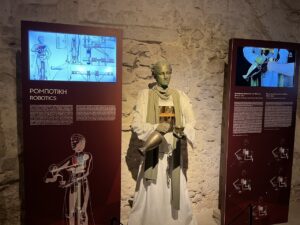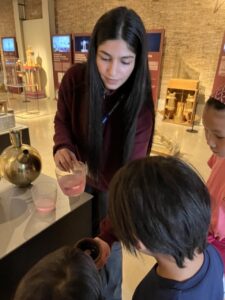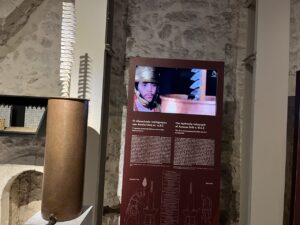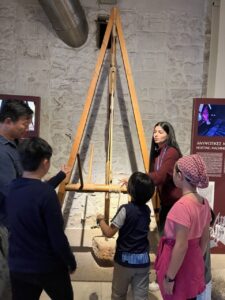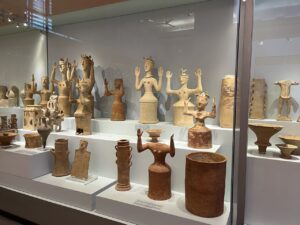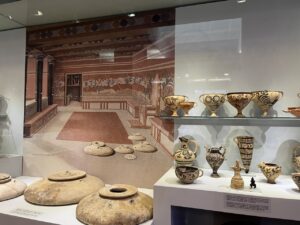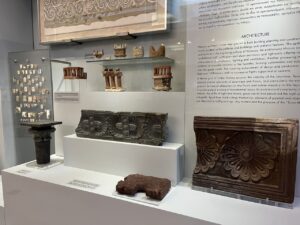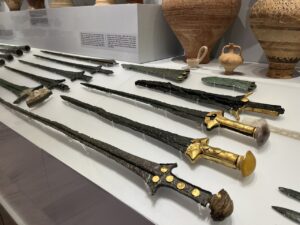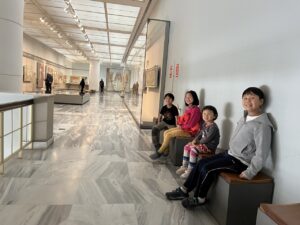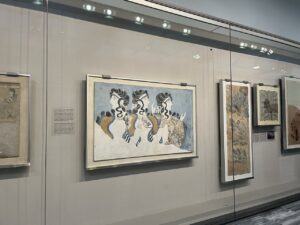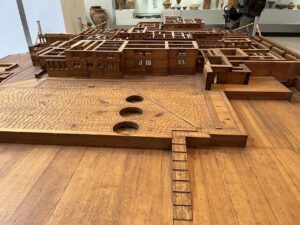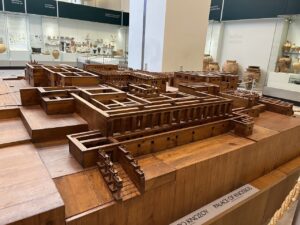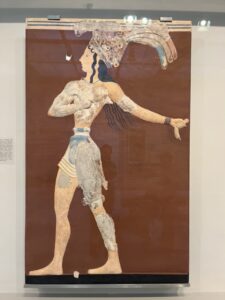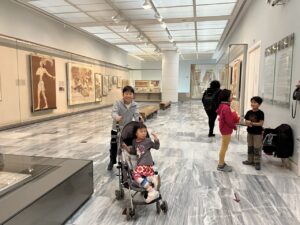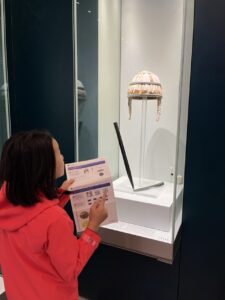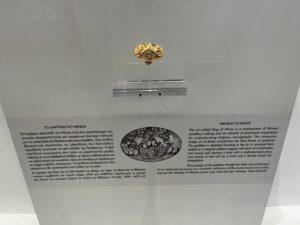We drove into Old Town Heraklion a couple of times to visit the Heraklion Archaeological Museum, the top museum in the world for Minoan culture and civilization. On our first try, we arrived late in the afternoon only to realize that the museum closes at 3:30 pm on most days. Instead of rushing through the museum, we decided to visit the Kotsanas Museum instead and save the Heraklion Archaeological Museum for another day.
Kotsanas Museum
The Kotsanas Museum showcases the technology of Ancient Greece. We weren’t exactly sure what to expect because technology isn’t one of the things that comes immediately to mind when you think of Ancient Greece. We were thinking mainly about culture, mythology, history and food. We entered the museum with an open mind and hoped to learn something new.
The privately owned museum has 75 exhibits complemented with interactive displays, audiovisual material, explanations, renderings and live demonstrations. We easily spent two hours enthralled by the fascinating inventions and technology that existed in ancient times.
Most of the inventions were created to solve problems or make life easier for the Ancient Greeks. Many of the inventions cleverly used laws pertaining to the natural world that the Ancient Greeks could intuit like gravity, air pressure, water pressure, buoyancy, steam pressure and others.
There were a number of inventions that helped to solve problems faced by religious temples. The world’s first vending machine was an automatic dispenser of holy water. When worshippers arrived at the temple, they would place a coin in the jug to receive a controlled volume of holy water.
One of our favorite inventions was the “Robot” who could move around and pour wine upon command.
Being served wine with the least effort seemed to inspire a lot of deep thinking by the Ancient Greeks because there was another invention that used air pressure to allow the server to pour the right combination of wine and water for each drinker.
I spent some time examining the “hydraulic telegraph” that allowed soldiers stationed at distant bastions to communicate with each other.
The kids were already familiar with simple machines so they enjoyed exploring the pulley and cranes that helped make it possible for the Ancient Greeks to build their monuments and temples.
There were so many fascinating exhibits that with more time and patience, you could really learn a lot. I could see that the kids were naturally curious about the exhibits and had a decent grasp of the science behind the inventions and technology. A lot of our travels and learning have been focused on history, archaeology and anthropology. Spending some time at Kotsanas Museum was enjoyable, worthwhile and a good reminder to push myself outside of my comfort zone.
heraklion Archaeological Museum
After our first unsuccessful attempt to visit the Heraklion Archaeological Museum, we returned a few days later in the morning. It turned out to be the right decision because the richness of the exhibits warrants a visit of at least two hours.
The Heraklion Archaeological Museum holds the world’s finest collection of artifacts and artwork from the Minoan civilization. Visits to the archaeological sites provide a big picture understanding of a civilization but the museum pieces offer deeper insight into their way of life –culture, art, politics and religion. Many of the exhibits come from Knossos and the rest from Phaistos and other Minoan settlements.
From our time spent at the museum, the Minoan civilization came into greater focus for us. The Minoans were an advanced civilization with a complex religious belief system, strong traditions and keen artistic sensibilities. They expressed their beliefs and traditions through beautiful frescoes and on everyday objects like pottery. They were capable of producing finely crafted bronze items including weapons and delicate gold jewelry. They developed a writing script called Linear A used for record keeping and communication that remains undeciphered still today. Linear A was taken by the Myceneans and used to develop Linear B script, which is the basis of the Greek language.
Some of the highlights from our visit:
Wooden model of the Palace of Knossos: It was amazing to see this model of the Palace of Knossos that shows how the palace looked at the height of Minoan power. The model is the most accurate 3D depiction of the palace and it accurately conveys how extensive and intricate the palace was. The palace included 1300 interconnected rooms and was up to five stories tall. Many roofs and walkways were decorated with bull horns, an important religious symbol for the Minoans.
Snake Goddesses: These two miniature statues are iconic symbols of the Minoan civilization. We had seen them in photos, brochures and documentaries before seeing them in real life at the museum. The female figures were likely goddesses or priestesses and were used for religious worship or in religious rituals at Knossos. The snakes present in both figurines symbolize the relationship of the female figure with the underworld.
Prince of the Lilies Fresco: This fresco, discovered at Knossos, is probably the most famous Minoan fresco. When we visited the Palace of Knossos, we saw a replica of this piece plastered on the wall. There are differing interpretations for the young man in the painting ranging from a ruler or “Priest-King” to athlete or boxer. The headdress made of waz-lily and peacock feathers is believed to hold religious significance and indicate that the wearer is of high status.
Bull Leaping Fresco: This fresco, discovered at the Palace of Knossos, depicts the popular Minoan sport of bull leaping. Men, colored in red paint, and women, colored in white paint, used acrobatic skill to leap from the ground onto the bull’s back and back onto the ground. This sport demonstrated the athlete’s strength, grace and courage to perform this difficult and dangerous maneuver.
Boar’s tusk helmet: This is a helmet not used for battle but as a symbol of status and rank. The helmet is made of wild boars’ tusks with cheek guards. Like many of the artifacts, this helmet was found in Knossos in a burial tomb with weapon and other objects belonging to a warrior.
Ring of Minos: This large gold signet ring was found in Knossos. It is difficult to make out the images on the ring without an explanation. It takes time and patience to try and make sense of tiny artifacts. The ring was placed in a special display case, separate from other artifacts in the room, signaling to us the significance of this piece, otherwise we could have easily overlooked it. The ring is significant and unique because the inscribed scene summarizes the Minoan belief of the order of the universe and the presence of the divine.
Toward the end of our visit, we encountered a friendly curator of the museum who was eager to share information about the exhibits. She also highly recommended for us to make a visit to the Palace of Phaistos, where she believed the best authentic ruins of the Minoan civilization could be found. She was not a fan of the “restoration” work performed by Sir Arthur Evans and believed he deviated from the true history of the Minoans by employing too much of his own imagination and interpretation to the site.
Author
-

Song is the mother of four children. She and her family have stepped away from it all and in September 2023, began traveling the world while homeschooling. Song is an ABC (American born Chinese) and has an undergraduate degree from Cornell and an MBA from Harvard. She is an entrepreneur and an educator. Her hobbies include learning, traveling, reading, cooking and baking, and being with children.



